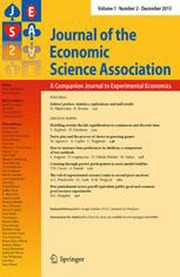No CrossRef data available.
Article contents
Indefinitely repeated contests with incumbency advantage
Published online by Cambridge University Press: 01 January 2025
Abstract
We study an indefinitely repeated Tullock contest in which the stage-game winner gains an incumbency advantage in the next stage-game. The incumbent's advantage allows the incumbent to carry over a proportion of their expenditure in the previous contest to the next contest. Theoretically, this advantage is not predicted to have a large impact on total expenditure. However, in a controlled laboratory experiment, we find the incumbency advantage increases total expenditure by a significant amount. Further, we find that carryover has a discouraging effect on challengers while encouraging incumbents react in a retaliatory manner.
Information
- Type
- Original Paper
- Information
- Copyright
- Copyright © The Author(s), under exclusive licence to Economic Science Association 2024.
References
Arellano, M, Bond, S. (1991). Some tests of specification for panel data: MonteCarlo evidence and an application to employment equations. Review of Economic Studies, 58, 2, 277–297. 10.2307/2297968.Google Scholar
Azrieli, Y, Chambers, C, Healy, P. (2020). Incentives in experiments with objective lotteries. Experimental Economics, 23, 1, 1–29. 10.1007/s10683-019-09607-0.Google Scholar
Baik, KH, Lee, S. (2000). Two-stage rent-seeking contests with carryovers. Public Choice, 103, 3–4, 285–296. 10.1023/A:1005003713923.Google Scholar
Brookins, P, Ryvkin, D, Smyth, A. (2021). Indefinitely Repeated Contests: An Experimental Study. Experimental Economics, 24, 1390–1419. 10.1007/s10683-021-09703-0.Google Scholar
Cooper, R, Dejong, D, Forsythe, R, Ross, T. (1996). Cooperation without Reputation: Experimental Evidence from Prisoner's Dilemma Games. Games and Economic Behavior, 12, 2, 187–218. 10.1006/game.1996.0013.Google Scholar
Dal Bo, P, Frechette, GR. (2018). On the Determinants of Cooperation in Infinitely Repeated Games: A Survey. Economic Literature, 56, 1, 60–114. 10.1257/jel.20160980.Google Scholar
Dechenaux, E, Kovenock, D, Sheremeta, RM. (2015). A survey of experimental research on contests, all-pay auctions and tournaments. Experimental Economics, 18, 4, 609–669. 10.1007/s10683-014-9421-0.Google Scholar
Descamps, A, Ke, C, Page, L. (2022). How success breeds success. Quantitative Economics, 5, 1, 355–385. 10.3982/QE1679.Google Scholar
Fischbacher, U. (2007). z-Tree: Zurich toolbox for ready-made economic experiments. Experimental Economics, 10, 2, 171–178. 10.1007/s10683-006-9159-4.Google Scholar
Gill, D, Prowse, V. (2014). Gender differences and dynamics in competition: The role of luck. Quantitative Economics, 5, 2, 351–376. 10.3982/QE309.Google Scholar
Grossmann, M, Dietl, H, Lang, M. (2010). Revenue sharing and competitive balance in a dynamic contest model. Review of Industrial Organization, 36, 1, 17–36. 10.1007/s11151-009-9236-x.Google Scholar
Hafer, C. (2006). On the origins of property rights: Conflict and production in the state of nature. Review of Economic Studies, 73, 119–143. 10.1111/j.1467-937X.2006.00371.x.Google Scholar
Häfner, Samuel, Nöldeke, Georg. (2019). Sorting in iterated incumbency contests. Economic Theory, 10.1007/s00199-019-01205-8.Google Scholar
Ham, JC, Kagel, JH, Lehrer, SF. (2005). Randomization, endogeneity and laboratory experiments: The role of cash balances in private value auctions. Journal of Econometrics, 125, 1–2, 175–205. 10.1016/j.jeconom.2004.04.008.Google Scholar
Holtz-Eakin, D, Newey, W, Rosen, HS. (1988). Estimating vector autoregressions with panel data. Econometrica, 56, 6, 1371–1395. 10.2307/1913103.Google Scholar
Konrad, KA. (2009). Strategy and Dynamics in Contests, Oxford University Press. 10.1093/oso/9780199549597.001.0001.Google Scholar
Polborn, M. (2006). Investment under uncertainty in dynamic conflicts. Review of Economic Studies, 73, 505–529. 10.1111/j.1467-937X.2006.0385.x.Google Scholar
Schmitt, P, Shupp, R, Swope, K, Cadigan, J. (2004). Multi-period rent-seeking contests with carryover: Theory and experimental evidence. Economics of Governance, 5, 3, 187–211. 10.1007/s10101-004-0075-9.Google Scholar
Virág, G. (2009). Efficiency and competition in the long run: The survival of the unfit. Games and Economic Behavior, 67, 1, 315–330. 10.1016/j.geb.2008.10.008.Google Scholar
Windmeijer, F. (2005). A finite sample correction for the variance of linear efficient two-step GMM estimators. Journal of Econometrics, 126, 1, 25–51. 10.1016/j.jeconom.2004.02.005.Google Scholar

